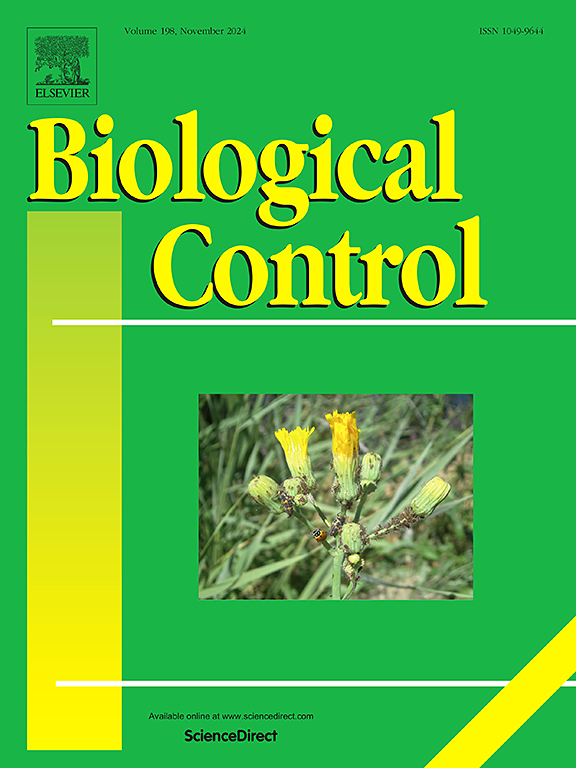Efficacy of Amblyseius swirskii (Athias-Henriot) (Acari: Phytoseiidae) and Alternaria destruens (Ascomycota: Pleosporaceae) for managing Phenacoccus solenopsis Tinsley (Hemiptera: Pseudococcidae)
IF 3.7
2区 农林科学
Q2 BIOTECHNOLOGY & APPLIED MICROBIOLOGY
引用次数: 0
Abstract
Phenacoccus solenopsis Tinsley (Hemiptera: Pseudococcidae) is a major pest of potatoes and other crops, highlighting the need for effective management strategies. This study evaluated the efficacy of a predatory mite and an entomopathogenic fungus, both individually and in combination, against P. solenopsis on potato plants under greenhouse (24.6–35.2 °C) and field conditions (24.9–35.9 °C). The treatments included: untreated control, Tween 80 (TW), the predatory mite Amblyseius swirskii (Athias-Henriot) (Acari: Phytoseiidae) (AS), the fungal pathogen Alternaria destruens (AD), AD + AS, and imidacloprid (ICP) (positive control). Treatment efficacy was evaluated weekly for five weeks, with predators released five days after fungal application. The AD + AS treatment significantly reduced P. solenopsis egg and motile stage counts compared to both initial levels and the individual treatments, reaching 9.88 eggs and 8.11 motile stages in greenhouse trials, and 9.22 eggs and 7.11 motile stages in field trials by week 5. The AD treatment alone caused the highest number of mummified mealybugs by week 5 (28.7 and 26.7 per plant in greenhouse and field trials, respectively), indicating strong pathogen-induced mortality. Amblyseius swirskii populations peaked at 34.8 and 26.7 mites per plant in the greenhouse and field, respectively, by week 3 in the AS alone treatment, with lower densities in the AD + AS treatment due to predator-fungus interactions. The AD + AS treatment effectively reduced P. solenopsis infestations while preserving the visual quality of treated plants (visual quality score > 9.50 by week 5), highlighting its potential for the management of P. solenopsis.

威氏钝绥螨(蜱螨亚纲:植物绥螨科)和施特鲁交螨(子囊菌科:多孢子虫科)对扶桑绵螨的防治效果
螺线管棘球绦虫(半翅目:假球虫科)是马铃薯和其他作物的主要害虫,需要有效的管理策略。在温室(24.6 ~ 35.2°C)和田间(24.9 ~ 35.9°C)条件下,研究了一种捕食性螨和一种昆虫病原真菌单独或联合对马铃薯番茄螺线虫的防治效果。处理包括:未处理对照,Tween 80 (TW),捕食性蜱螨(Athias-Henriot)(蜱螨:植物绥螨科)(AS),真菌病原菌灭稻瘟螨(AD), AD + AS和吡虫啉(ICP)(阳性对照)。每周评估治疗效果,持续五周,在真菌应用后五天释放捕食者。与初始水平和单独处理相比,AD + AS处理显著降低了索理螺梭线虫卵和活动期数量,第5周温室试验达到9.88个卵和8.11个活动期,田间试验达到9.22个卵和7.11个活动期。在第5周,单独的AD处理导致的粉蚧干尸数量最多(温室和田间试验中分别为28.7只和26.7只/株),表明病原引起的死亡率很高。单用AS处理第3周时,温室和田间的威氏钝绥螨数量最高,分别为34.8和26.7只/株,而AD + AS处理由于捕食者与真菌相互作用,种群密度较低。AD + AS处理有效地减少了扶桑opsis的侵染,同时保持了处理植株的视觉质量(视觉质量评分>;9.50(第5周),突出了其在扶桑螺旋藻管理方面的潜力。
本文章由计算机程序翻译,如有差异,请以英文原文为准。
求助全文
约1分钟内获得全文
求助全文
来源期刊

Biological Control
生物-昆虫学
CiteScore
7.40
自引率
7.10%
发文量
220
审稿时长
63 days
期刊介绍:
Biological control is an environmentally sound and effective means of reducing or mitigating pests and pest effects through the use of natural enemies. The aim of Biological Control is to promote this science and technology through publication of original research articles and reviews of research and theory. The journal devotes a section to reports on biotechnologies dealing with the elucidation and use of genes or gene products for the enhancement of biological control agents.
The journal encompasses biological control of viral, microbial, nematode, insect, mite, weed, and vertebrate pests in agriculture, aquatic, forest, natural resource, stored product, and urban environments. Biological control of arthropod pests of human and domestic animals is also included. Ecological, molecular, and biotechnological approaches to the understanding of biological control are welcome.
 求助内容:
求助内容: 应助结果提醒方式:
应助结果提醒方式:


